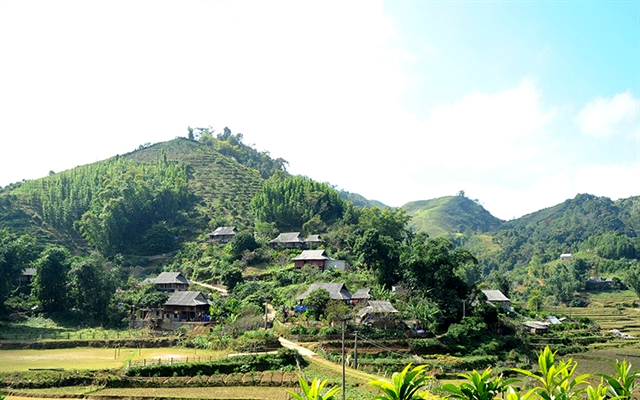 Society
Society

Deputy Prime Minister Trịnh Đình Dũng has assigned the Central Steering Committee for Natural Disaster Prevention and Control and the Ministry of Agriculture and Rural Development (MARD) to work with other ministries and localities concerned to build a master plan on prevention and control of natural disasters for mountainous areas.
 |
| Deputy Prime Minister Trịnh Đình Dũng has assigned the Central Steering Committee for Natural Disaster Prevention and Control and the Ministry of Agriculture and Rural Development to work with other ministries and localities concerned to build a master plan on prevention and control of natural disasters for mountainous areas during a conference held on Sunday. — VNA/VNS Photo Vũ Sinh |
HÀ NỘI — Deputy Prime Minister Trịnh Đình Dũng has assigned the Central Steering Committee for Natural Disaster Prevention and Control and the Ministry of Agriculture and Rural Development (MARD) to work with other ministries and localities concerned to build a master plan on prevention and control of natural disasters for mountainous areas.
The move aims to fix problems that still exist in the prevention and control of natural disasters, said the Deputy PM at a conference discussing the response to the seventh storm and post-storm floods and rains in Hà Nội on Sunday (August 27).
The master plan is needed to prevent landslides and flash floods in combination with restructuring residential areas and mainstreaming the efforts to ensure sustainable livelihoods with that to protect and develop protective forests in key areas. It is asked to be submitted to the Prime Minister.
The Deputy PM asked localities to keep a close eye on the movements of the seventh storm (internationally known as Pakhar) and its possible threats to minimise losses and damage.
By Sunday noon, typhoon Pakhar made landfall on the southern part of Guangdong province, China, bringing gales of up to 33 metres per second. It is forecast to weaken into a tropical depression and likely cause torrential rains.
He asked localities prone to rains and flooding to continue reviewing areas vulnerable to flash floods and landslides and proactively design plans to evacuate residents while the national committee for search and rescue prepares forces and vehicles to support localities.
In the long term, MARD needs to work on a map of geographic accidents in general and landslides in particular. The environment ministry is also asked to coordinate with professional agencies to soon organise a seminar on geographic accidents and build a project to develop a weather monitoring system in areas vulnerable to natural disasters.
Natural disasters have so far this year left 116 people dead and missing, destroyed 1,030 houses, and caused economic damage of over VNĐ5.6 trillion (US$246.3 million).
Post-storm heavy rains
When storm No 7 weakens, torrential downpours are forecast to hit northern regions starting from Monday through Thursday (August 28-31), with mountainous provinces of Lào Cai, Lai Châu, and Hà Giang bearing the brunt of the rainfall, in addition to possible cyclones and strong gusts.
Trần Quang Hoài, head of the General Department for Natural Disasters Prevention and Control, under MARD, said heavy rain in coming days will continue to pound areas hit hardest by the Hato typhoon just a few days ago, leading to alarming risks of landslides and flashfloods as the soil is already saturated with water. In addition, hydropower reservoirs are facing crippling pressure as China is also discharging their floodwaters at a high rate of 9,500cu.m a second.
Floods show limits of forecasting system
Flash floods this month killed 26 people and caused tremendous economic losses, and most importantly, they laid bare the shortcomings of efforts to predict where and when such floods and landslides will strike.
Scientists have been working since 2012 to map zones in 12 northern mountainous and northern-central provinces prone to landslides and flash floods so that localities can predict the risks they face from a period of heavy rain. But Trần Tân Văn, head of the Geoscience and Mineral Institute under the Ministry of Natural Resources and Environment, said that results of these surveys and maps accurately predicted just 60 to 70 per cent of the eventual flood strength and locations.
“It was difficult to make a 100 per cent-correct forecast,” he said.
The lack of good forecasting for the impacts of torrential rains contributed to their heavy toll.
Deputy Director of the National Hydro-meteorological Forecast Centre Đặng Thanh Mai said forecasting landslides and flash floods posed many challenges. Forecasts are chiefly based on terrain maps and information about rainfall gleaned from satellite observations. They failed to give correct and detailed information about the timing, location and scale of landslides and flash floods, and instead provided warnings about broad areas that could be vulnerable, she said.
One large shortcoming in the forecasting system was the absence of any observation system to measure rainfall in remote mountainous areas and at the upper stream of rivers, she said.
The destruction and death caused by recent floods have spurred the Government to rethink its efforts to predict floods and limit the damage they inflict.
According to Văn, localities should use maps to restrict development in areas at risk of flash floods and landslides as a long-term solution to the threat of natural disaster.
Experts suggested that localities themselves should resolve to move residents out of areas prone to landslides and flash floods, in addition to strengthening forecasting programmes. — VNS



.jpeg)
